A cavity on a front tooth can be small at first, but it doesn’t take long for it to grow and affect your smile. It might show up as a light spot, a bit of roughness, or a shadow near the edge of your tooth. Because front teeth are so visible, even a small cavity can feel like a big deal.
The good news is that there are simple ways to treat it. Fillings and bonding can match your natural tooth color and restore your smile without making it obvious anything was done.
In this guide, you’ll learn what causes front tooth cavities, how to spot them early, how dentists fix them, and what habits help keep your front teeth healthy. Visiting your dentist for a regular dental check-up is one of the easiest ways to catch small issues before they become something more serious.
What is a Cavity on Front Tooth?
A cavity on front tooth usually starts with gradual front tooth decay. When food particles and bacteria build up, they create plaque, a sticky, yellowish film you often notice before brushing. Over time, this plaque traps bacteria against the tooth surface, slowly breaking down the enamel. Enamel is the hard, protective layer on your teeth. Once the damage reaches the inner layers, the front tooth cavity can cause pain or even infection. That’s why early treatment matters.
While many people think tooth decay front teeth happens only in back molars, that’s not the case. You can also get cavities on front teeth, and even a cavity in front bottom tooth is common. In fact, front teeth may seem easier to keep clean, but they still have grooves and edges where plaque can hide. If you’re not brushing well, you can develop cavities between front teeth or even a small hole in front tooth. These are all signs of a possible cavity front tooth, and they shouldn’t be ignored.
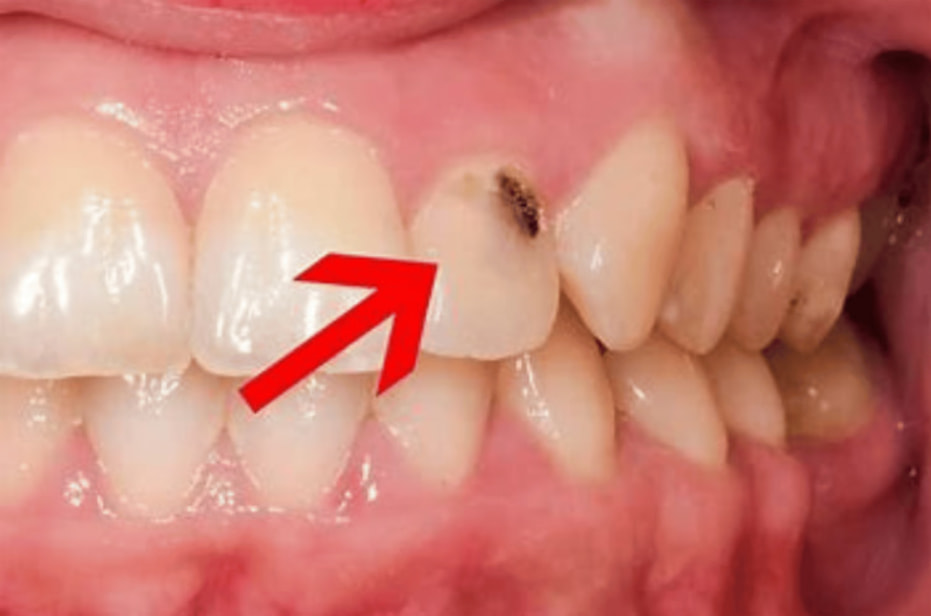
What Does a Front Tooth Cavity Look Like?
A cavity on a front tooth often begins as a small white spot, indicating early enamel demineralization. As decay progresses, this spot may darken to brown or black and can develop into a visible hole or pit. These changes are more noticeable on front teeth due to their prominent position in your smile. If you observe any discoloration or surface irregularities on your front teeth, it’s advisable to consult a dentist promptly to prevent further damage.
Common Causes of Front Tooth Cavities
Cavities in front teeth usually happen for the same reasons they appear anywhere else, but there are a few things that make front teeth more at risk. These teeth are exposed more often, and people tend to overlook them when cleaning. Here are some of the most common reasons cavities can form on your front teeth:
Poor brushing and flossing
When plaque builds up and stays on your teeth, it creates acid that eats away at the enamel. If you’re not brushing well or skipping flossing, that acid can start to damage your front teeth, especially near the gumline or between teeth.
Too much sugar
According to the American Dental Association, tooth decay happens when plaque interacts with sugars and produces acid that weakens enamel and leads to cavities. Eating or drinking a lot of sugar feeds the bacteria in your mouth. That bacteria produces acid that weakens enamel. Since front teeth are exposed more while eating and drinking, they’re especially vulnerable.
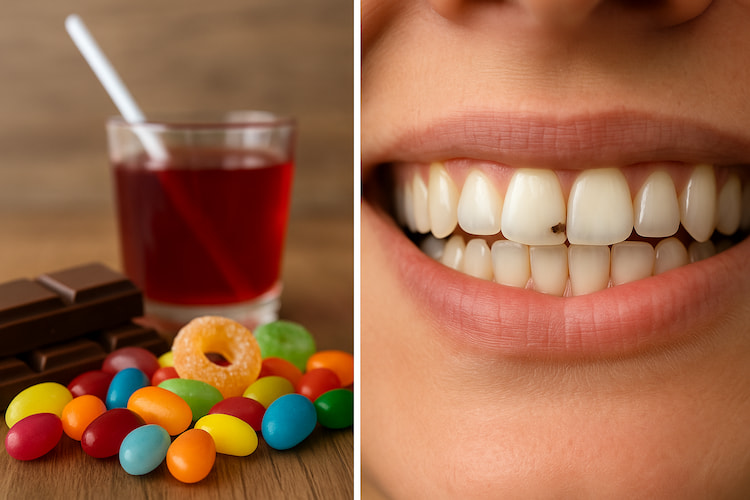
Acidic foods and drinks
Soda, citrus fruits, and vinegar-based foods can wear away enamel over time. When enamel becomes thin or soft, it’s easier for cavities to form.
Dry mouth
Saliva protects your teeth by washing away food and balancing acid. When your mouth is dry, especially from certain medications or health issues, bacteria and acid build up faster.
Crooked teeth
If your teeth are crowded or misaligned, it’s harder to brush and floss properly. Plaque can collect in tight spots, making the front teeth more likely to decay.
Gum recession
When your gums pull back, they expose the roots of your front teeth. Roots don’t have enamel, unlike the tooth crown, so they’re more sensitive and decay faster.
Mouth piercings
Lip or tongue piercings can rub against your front teeth and slowly wear down the enamel. If that layer gets too thin, cavities are more likely to start.
Tooth injury
A small crack or chip from a fall, accident, or even biting into something hard can open the door for bacteria. Once it gets inside, it can lead to decay from within.
Family history
Sometimes, it’s not just habits. Some people are more prone to cavities because of their genetics. If your family has a history of weak enamel or frequent dental issues, you may need to be more proactive with care.
Low fluoride exposure
Fluoride helps protect and rebuild enamel. If you don’t use fluoride toothpaste or your local water isn’t fluoridated, your teeth might be more at risk.
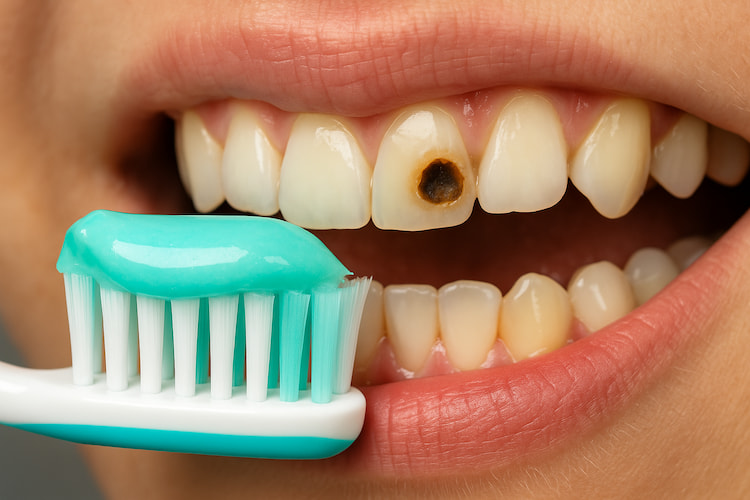
Early Signs and Symptoms to Watch For
Cavities on front teeth can be easy to miss in the early stages, but there are some clear signs you can watch for. Catching them early helps avoid more serious damage and keeps your smile healthy.
| Symptom | What It Might Mean |
|---|---|
| Visible discoloration | A cavity on front tooth may start as a white spot and turn brown or black as it gets deeper. This is often one of the first signs. |
| Sensitivity | If your front teeth react to hot, cold, or sweet foods, it could point to front tooth decay or a small cavity on front tooth. |
| Pain while chewing | Pain or pressure when biting may mean the decay has reached the dentin or nerve, especially in a cavity front tooth. |
| Roughness or a hole | If your tooth feels uneven or you notice a hole in front tooth, it could be a sign of surface breakdown caused by a cavity. |
| Bad breath | Cavities in front teeth can trap bacteria, which may lead to bad breath even if you brush regularly. |
If you notice any of these symptoms, your dentist can help with early front teeth cavity treatment options that blend naturally with your smile.
Stay Ahead of Front Tooth Decay
Even with great daily habits, only a professional can catch what you might miss. If you’re starting to feel sensitivity, see a stain, or notice a rough spot on a front tooth, now’s the time to act.
At Smile Plus Dentistry, we help you catch problems early and keep your smile healthy with gentle, preventive care.
Don’t wait for it to get worse. Call us today.
How to Treat a Cavity on a Front Tooth
Treating cavities on front teeth requires precision to ensure the dental work is virtually undetectable. The most typical way of fixing cavities in your front teeth is via filling. A dental filling for front teeth is often made of tooth-colored materials, providing a natural look after a tooth filling on front teeth is completed, ensuring your smile remains intact. These materials can correspond to the color of the rest of your tooth. Yet, you can still opt for other materials like silver or gold.
Fillings
To treat front tooth cavities, dentists recommend a front tooth cavity filling as a first step. This procedure removes the decayed portion and fills the gap with a durable material that blends in, ensuring that tooth decay on front teeth is no longer an issue while maintaining your smile’s aesthetics. We must do this carefully because the front teeth are much narrower, and we don’t want to break or chip the tooth. After meticulous drilling, we can refill the cavity, but we don’t do it with a metal filling.
Instead, we may use a composite resin or porcelain filling. The benefit is that we can color the resin or porcelain material to fit the color of your tooth, making the filling much more challenging to see. The most common types of tooth fillings are:
- Amalgam Fillings: Amalgam fillings are some of the most robust, durable, and visible. They’re usually made of an amalgamation of various metals, such as mercury, silver, copper, etc. Amalgam fillings are generally set on some posterior teeth because they’re not tooth-colored but can withstand the considerable bite force forged in the molars.
- Composite Fillings: As said earlier, composite fillings are also known as tooth-colored fillings because they can match the color of your other teeth. They’re perfect for small- to medium-sized cavities and can only tolerate mild-to-medium bite force, making them fit for the front but not the back teeth.
- Metallic Fillings: Metallic fillings are usually amalgams of gold and silver and can last 10 to 15 years. They’re apparent but more robust and more long-lasting than tooth-colored fillings.
- Ceramic Fillings: Ceramic or porcelain fillings are also natural-looking and tooth-colored. Unlike composite fillings, they’re stainless and don’t show stains. However, ceramic fillings are as expensive or more expensive than gold fillings.
- Glass Ionomer Fillings: A glass ionomer combines acrylic and glass that releases fluoride into the teeth to protect them from bacterial infections. However, glass ionomer fillings aren’t as durable as other fillings.
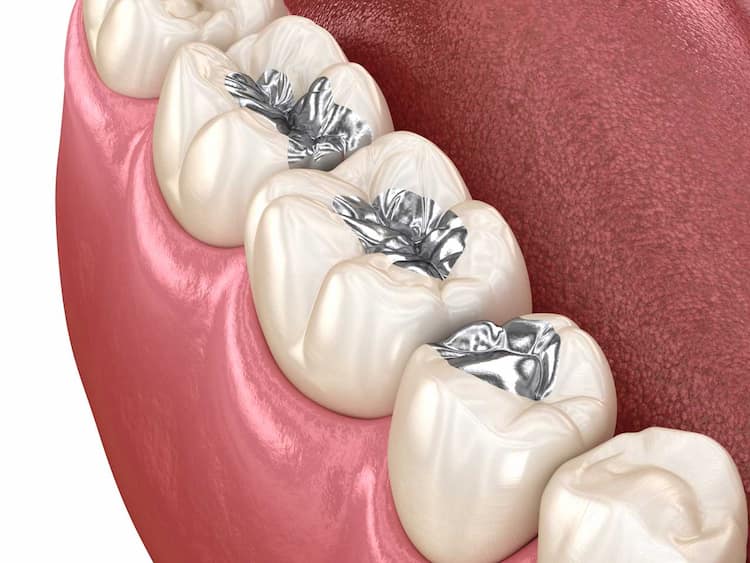
Veneers
Leaving a cavity too long can destroy the tooth. In this case, we need to do more to revive its look. That’s where our cosmetic dentistry assistance comes in!
One alternative we can provide is a porcelain veneer to restore the tooth’s appearance. We can fit the veneer to the surrounding teeth so it looks natural. To add a veneer, we’ll first stop the cavity so it doesn’t continue to grow. Then, we’ll extract some of the enamel from the front of the tooth and install the veneer with a potent dental bonding agent. Your tooth will look as good as a new tooth!
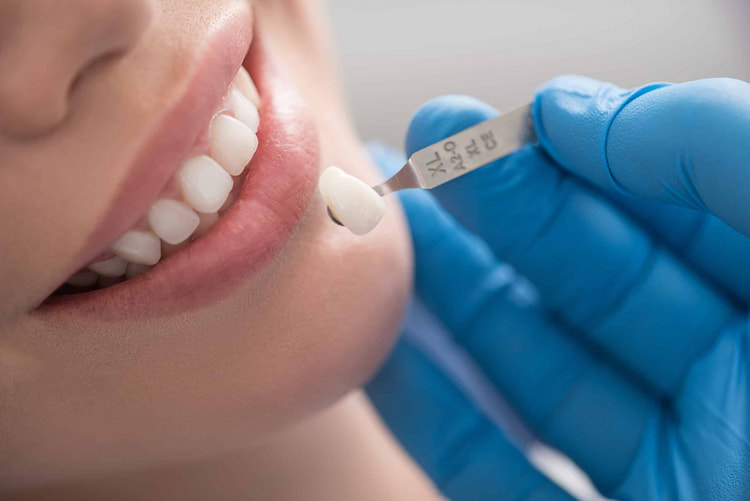
Crowns
What happens if the cavity causes you to lose a corner of a tooth? We can conceal that absent area with a crown. Unlike veneers, crowns protect the entire tooth instead of just sitting on the front shell. Like veneers, dental crowns can be fitted in color to the surrounding teeth, causing them to look like a realistic part of your smile.
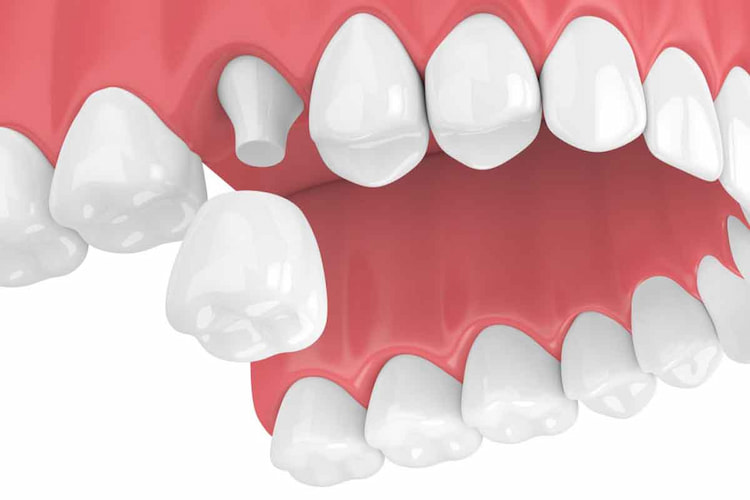
Root Canal
If a front tooth cavity goes too deep, it can reach the pulp, which is the soft inner part of the tooth that holds nerves and blood vessels. When the pulp becomes infected or damaged, root canal treatment is often needed to save the tooth. In this procedure, the dentist removes the infected tissue and fills the space with a special material. The tooth is then sealed with resin or porcelain to match the natural look of your smile.

Prevention Tips to Avoid Cavities on Front Teeth
Taking care of your front teeth is key to keeping your smile healthy and cavity-free. Here are the best ways to prevent a cavity on the front tooth and stop decay before it starts:
1. Brush and floss every day
Proper brushing and flossing remove plaque that leads to front tooth decay. Use a soft-bristled toothbrush and fluoride toothpaste to clean all tooth surfaces. Floss once daily to reach areas between teeth where a cavity between front teeth can easily develop. Pay close attention to the gumline of your front teeth, where food often sticks and plaque builds up.
2. Cut back on sugary and acidic foods
Sugar and acid feed the bacteria that cause cavities on front teeth. Candy, soda, fruit juice, and even dried fruit can weaken enamel over time. Try to eat these less often, and rinse your mouth with water afterwards to reduce acid levels. Long-term exposure increases the risk of a small cavity on front tooth that may not be visible at first.
3. Use fluoride products regularly
Fluoride helps repair early enamel damage and prevents future decay. Along with fluoride toothpaste, consider a fluoride mouthwash or ask your dentist about in-office fluoride treatments. These are especially useful if you’re prone to front tooth cavities or have early signs of tooth decay in front teeth.
4. Drink more water throughout the day
Water rinses away food and keeps your mouth from drying out. It also supports healthy saliva production, which helps balance pH and wash away acid. A dry mouth can speed up the formation of a cavity in front tooth, especially after meals or during sleep.
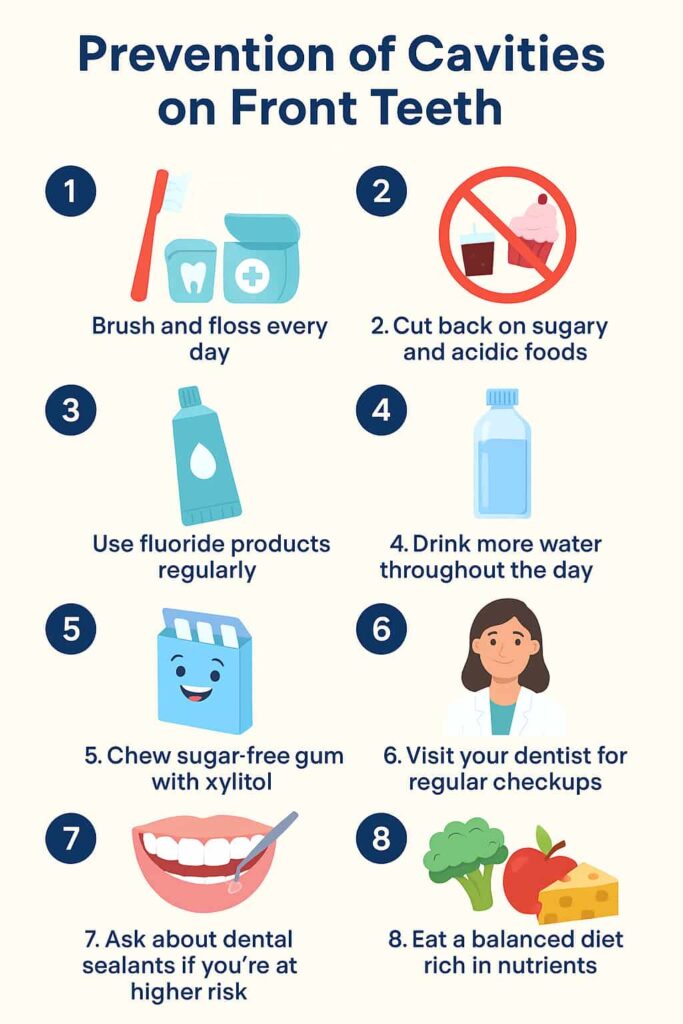
5. Chew sugar-free gum with xylitol
Chewing gum boosts saliva and helps reduce the bacteria linked to cavities front teeth. Look for sugar-free gum that contains xylitol, a natural sweetener shown to reduce plaque buildup and acid production.
6. Visit your dentist for regular checkups
A dental check-up every six months lets your dentist catch small problems early, like a developing front tooth cavity or plaque that regular brushing may miss. Professional dental cleaning helps prevent front teeth cavity treatment down the road by removing hardened tartar and polishing enamel.
7. Ask about dental sealants if you’re at higher risk
Though sealants are more common on molars, they may be applied to front teeth with deep grooves or signs of enamel wear. This protective layer can lower the chance of a front tooth cavity filling later on.
8. Eat a balanced diet rich in nutrients
Choose foods that support oral health. Dairy products like cheese and yogurt provide calcium. Crunchy vegetables help clean teeth. Avoid sticky, starchy snacks that can cling to the front of tooth surfaces and encourage decay. A strong diet makes it easier to resist cavity front tooth damage over time.
Conclusion
Cavities on front teeth might seem small at first, but they can affect both your comfort and confidence if not treated early. The good news is they’re easy to manage when you catch them on time. With daily care, regular checkups, and a better understanding of what to watch for, you can keep your front teeth strong and your smile looking great.
If you’re dealing with a cavity or noticing sensitivity, staining, or a rough spot on your front tooth, we’re here to help. At Smile Plus Dentistry, we offer complete care for cavities, including cosmetic solutions in Surrey that blend naturally with your teeth. We also provide emergency dental services if something unexpected comes up. Whatever you need, our team is ready to support you with trusted, professional care.
FAQs:
Can a cavity on my front tooth be filled without affecting my smile?
Yes, cavities on front teeth can be treated with tooth-colored fillings that match your natural enamel. These materials are carefully shaped and polished, so they blend in seamlessly and preserve the appearance of your smile.
Are cavities on front teeth more noticeable than those on back teeth?
Yes, front tooth cavities are usually more visible when you smile or speak. Even small discolorations or chips can stand out, which is why early treatment is key to maintaining both oral health and appearance.
Can cavities on front teeth be reversed without fillings?
Early-stage cavities (white spots) may be reversed with fluoride, improved hygiene, and diet changes. Once the decay breaks through the enamel, though, it cannot heal on its own and will need a dental filling.
How long does a front tooth filling last?
Composite fillings on front teeth can last 5 to 15 years or more with proper care. Longevity depends on oral hygiene, bite pressure, and habits like nail biting or using teeth to open packages.
What are the risks of leaving a front tooth cavity untreated?
If untreated, a cavity can deepen, cause pain, damage the nerve, and lead to infection or tooth loss. It may also affect the appearance of your smile and lead to more costly treatment later on.
What are the best treatments for front tooth cavities?
The best treatments include tooth-colored composite fillings, dental bonding, or veneers depending on the severity. Early decay may be managed with fluoride, while more advanced cases need restorative procedures for strength and appearance.
Have You Ever Dealt with a Front Tooth Cavity? We’d love to hear from you. Have you noticed early signs like a white spot or sensitivity on your front teeth? What helped you the most with treatment or prevention?
Share your experience in the comments below. Your story might help someone else protect their smile, too.

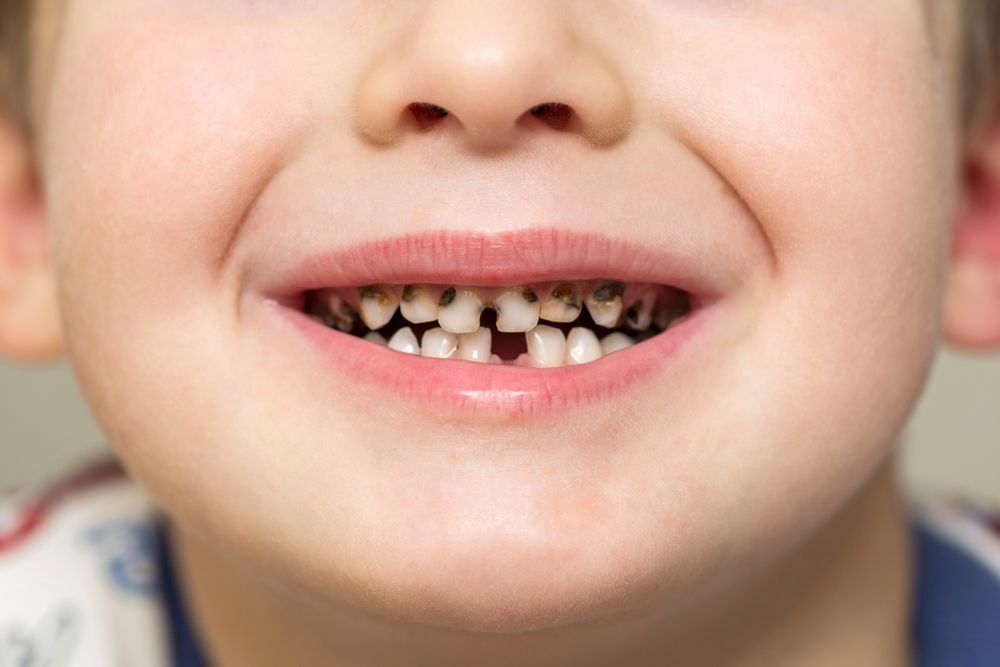
No Comments